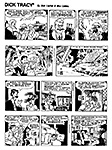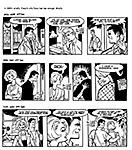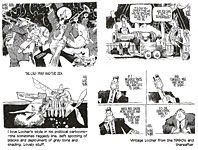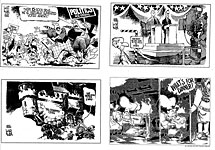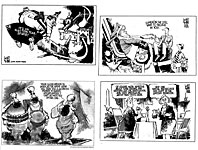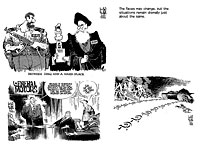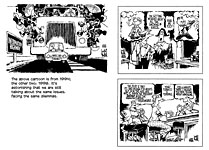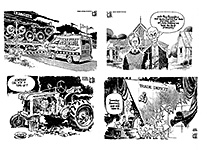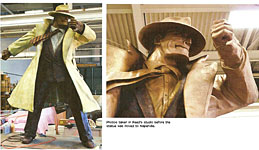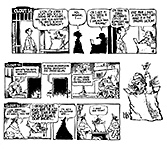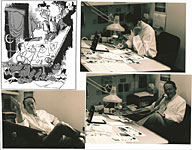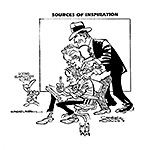 |
|||||||||
Opus 370a (August 31, 2017). This was supposed to be Opus 370, but when the page count reached more than 50, we decided to cut it in half to present two readable-sized postings instead of one stupendous-unreadable-at-one-sitting monster. This one focuses on editorial cartoons of the past month’s Trumpus Rumpuses (Trump’s gaffes over Charlottesville, his racism and harangue against news media) and Confederate monuments and maligned Robert E. Lee) and more, plus an affectionate farewell to Dick Locher. Next time, Opus 370b, more news and reviews of all sorts–in a week or so. Until then, here’s what’s here, in order, by department—:
NOUS R US Setback for Rall Stan Lee on Race and Hate Brooke Is Back Turk Cartoonist Defends Himself Zunar Keeps Up the Good Fight Russian Fined for Posting Jesus Cartoons
EDITOONERY The Antics of the Trumpet and Other Political Machinations
ONWARD, THE SPREADING PUNDITRY Trumpus Rumpus Before and After Charlottesville
PASSING THROUGH Dick Locher
ROBERT E. LEE, SOME THOUGHTS And What To Do with Confederate Monuments
QUOTE OF THE MONTH If Not of A Lifetime “Goddamn it, you’ve got to be kind.”—Kurt Vonnegut
Our Motto: It takes all kinds. Live and let live. Wear glasses if you need ’em. But it’s hard to live by this axiom in the Age of Tea Baggers, so we’ve added another motto:. Seven days without comics makes one weak. (You can’t have too many mottos.)
And our customary reminder: don’t forget to activate the “Bathroom Button” by clicking on the “print friendly version” so you can print off a copy of just this installment for reading later, at your leisure while enthroned. Without further adieu, then, here we go—:
NOUS R US Some of All the News That Gives Us Fits
ANOTHER SETBACK FOR RALL Cartoonist Ted Rall faced another setback in his defamation and wrongful termination lawsuit against the Los Angeles Times when a Superior Court judge lately granted Tribune Media’s motion to strike his complaint under the First Amendment, reported Matt Reynolds at courthousenews.com. “Rall is a nationally syndicated cartoonist based in New York. He sued the Times and its then-corporate owner Tribune Company in March 2016, claiming the paper wrongfully fired him over an opinion piece he wrote about a 14-year-old jaywalking incident and an ensuing confrontation with a motorcycle police officer.” Our report on the case is Opus 342a (August 26, 2015); humiliatingly, the Times fired Rall publicly on the newspaper’s website. Rall said he will appeal. Reading Reynolds’ report, it looks as if Judge Joseph Kalin decided everything Rall wrote about the Times’ behavior lacks evidentiary support. That’s not how I read it; see Opus 342a. Said Rall: “Watching the Times repeatedly lie and dissemble in my case makes me wonder if readers can trust anything they print. Now more than ever, Americans need an honest and independent free press to report the truth – yet LA Times management continues to defend its shameful collusion with and corruption by LAPD Chief Charlie Beck, for whom the Times fired and defamed me.”
STAN LEE ON RACE AND HATE At the Washington Post’s Comic Riffs, Michael Cavna remembered what Stan Lee had told him last fall about Marvel characters and allegorical response to the protests and violence and racial hate he saw playing out on America’s streets. “I always felt the X-Men, in a subtle way, often touched upon the subject of racism and inequality, and I believe that subject has come up in other titles, too,” Lee said, referring to his ’60s-born superheroes who feel like outsiders, “but we would never pound hard on the subject, which must be handled with care and intelligence.” In the wake of the violence in Charlottesbille, Lee tweeted the anti-bigotry message of a vintage “Stan’s Soapbox” (in italics below), which Lee called “as true today as it was in 1968,” when he penned it. Let’s lay it right on the line. Bigotry and racism are among the deadliest social ills plaguing the world today. But, unlike a team of costumed supervillains, they can’t be halted with a punch in the snoot or a zap from a ray gun. The only way to destroy them is to expose them—to reveal them for the insidious evils they really are. The bigot is an unreasoning hater—one who hates blindly, fanatically, indiscriminately. If his hang-up is black men, he hates ALL black men. If a redhead once offended him, he hates ALL redheads. If some foreigner beat him to a job, he’s down on ALL foreigners. He hates people he’s never seen—people he’s never known—with equal intensity—with equal venom. Now, we’re not trying to say it’s unreasonable for one human being to bug another. But, although anyone has the right to dislike another individual, it’s totally irrational, patently insane to condemn an entire race—to despise an entire nation—to vilify an entire religion. Sooner or later, we must learn to judge each other on our own merits. Sooner or later, if man is every to be worthy of his destiny, we must fill our hearts with tolerance. For then, and only then, will we be truly worthy of the concept that man was created in the image of God—a God who calls us ALL —his children.
BROOKE IS BACK Brooke McEldowney, who produces the syndicated newspaper comic strip 9 Chickweed Lane (one of my all-time favorite strips, supremely compassionate and comedic in an admirably adult way) and the online Pibgorn (about a sprite and others of that flighty sort), suffered a stroke in July. He was unable to “function as a cartoonist for a while,” but he now (mid-August) reports that he is “much better and am back in the saddle with 9 Chickweed Lane [which has been in reruns for a while], which returns [with original material] on August 28. “However,” he continues, “I’m still not quite up to full force, which has left Pibgorn in the lurch. For this, I am sorry, and I beg your forgiveness. What I believe I will do, in the meantime, is run a replay of ‘The Djinn of It,’ a story that began tooling along in one direction but quickly altered into a far improved tale I had not intended at all. I’m not sure if I will run it 5 times a week, or thrice weekly. But I’ll get it going nonetheless, and see what strikes me as the best frequence to assume.” Pibgorn can be seen at GoComics.com.
TURKISH CARTOONIST DEFENDS HIMSELF Cartoonist Musa Kart, currently on trial in Turkey for "supporting terrorism" by drawing cartoons critical of the government, has released the statement he gave to the court, announced the Association of American Editorial Cartoonists (AAEC) on July 26 . Kart, who has been in prison for the last nine months, is one of 16 journalists from the newspaper Cumhuriyet who were arrested in the aftermath of a failed coup against the Turkish president in 2016. The trial has raised worldwide concerns over freedom of the press, and coverage of the proceedings has garnered international attention. Kart's speech before Turkey’s 27th Heavy Penal Court in Istanbul has been translated into English and is available at the AAEC website, http://news.editorialcartoonists.com/aaec/2017/07/musa-karts-trial-statement-released.html I’m posting a couple excerpts here, in italics—: Essentially, the cartoon is an art form of an age in which a free mind and inquisitive freedom of thought began to express themselves. It is against the very nature of things for cartoons and their creators to align themselves with a culture of submissiveness and with entities that are unbending and based upon crude hierarchical relations that promote violence. Courageous and independent view points that have broken free of cliché and standardised forms are what make for a true and effective cartoon. Conversely, organisational structures based upon strict hierarchical relations cannot create a platform upon which a cartoonist can seek the freedom they need. Whilst organisational structures that are based upon violence rely upon taboos, the role of humour and of cartoons is to categorically destroy taboo. For that reason, those opposed to democracy do not like humorists, and humorists, likewise, have no time for structures that worship violence. In the face of this reality, to accuse a cartoonist of aiding and abetting a terrorist organisation and to punish them with a heavy prison sentence is not only a great misdeed to the cartoonist, but to this country itself. Like the foregoing, much of Kart’s statement demonstrates the contradictory aspects of his situation. He points out that his anti-terrorist cartoons “have appeared on the front page for the last six years,” a fact that is itself “further proof that my paper should not be held up as being aligned with a terrorist organisation.” And he finishes by reporting what “everybody knows”—that “the prosecutor who prepared this indictment is facing two life sentences and is being tried as a FETO [the terrorist organization] suspect and for instigating the coup.”
ZUNAR KEEPS UP THE GOOD FIGHT By Maren Williams at the Comic Book Legal Defense Fund (CBLDF) Once again, Malaysian political cartoonist Zunar has filed a lawsuit against police seeking the return of books and t-shirts that were seized in a raid of one of his public fan events. He also wants to recoup lost sales of about $5,200 for the merchandise taken from his “Tea with Zunar” fundraiser last December. Although Zunar has been harassed by police for years due to his cartoons and currently is awaiting trial on ten counts of sedition, he has won some judicial victories in the past. Most recently in April of this year, a court awarded him damages for books and original art that were seized in 2010. The wait for a resolution in this newest suit is likely to be just as long, but his lawyer N. Surendran explained in a statement yesterday that any future raids will be met with the same response (in italics): If again, in future Zunar does another exhibition, whoever tries to do this again, be it the police or anybody else, we will take you to court and you will have to answer to the court. There will be no more tolerance for this kind of unlawful behaviour against a person whose only crime is to criticise the authorities. That is the democratic right of every Malaysian. Zunar and two of his employees were arrested at the December tea and questioned for eight hours on suspicion of “activities detrimental to parliamentary democracy” before being released on bail. Two fans in attendance were also arrested for filming the police as they descended on the event. Apart from the police harassment, Zunar has also recently faced serious threats from the youth wing of ruling party UMNO, whose members formed a mob that shut down an exhibit of his work last November. Ironically the only arrest following that incident was of Zunar himself, after UMNO Youth filed a complaint against him for “intentionally humiliating a person”— that person being Prime Minister Najib Razak, who naturally features prominently in his political cartoons. Prior to those two arrests in quick succession last year, Zunar was already facing nine counts of sedition which stem from statements that he made on Twitter in February 2015 following the sentencing of opposition leader Anwar Ibrahim on a trumped-up sodomy charge. The cartoonist hinted that the judiciary in that trial had been subject to political pressure or bribery, observing that “the lackeys in black robes are proud of their sentences. The reward from political masters must be plenty.” He then exchanged Twitter barbs — and a cartoon — with Inspector-General of Police Khalid Abu Bakar as officers were en route to arrest him. His trial has been delayed multiple times, but is currently scheduled for November; if convicted, he could face up to 43 years in prison. The government also has barred him from leaving the country until his case is resolved.
Russian Man Fined for Posting Jesus Cartoons on Social Media By Maren Williams at CBLDF; August 10, 2017 A man in Sochi, Russia was convicted last week of “offending religious believers’ feelings” by sharing several satirical cartoons of Jesus Christ on social media in 2014. Although he has since deleted the cartoons, Viktor Nochevnov was prosecuted under a 2013 law on “insulting religious sensitivities” and fined 50,000 rubles or about $830. According to Radio Free Europe, the 32-year-old Novchevnov and his lawyer Aleksander Popkov plan to appeal the verdict. Popkov released a statement saying that “Sochi authorities have recently donned the costumes of inquisitors and are leading a quiet battle for religious sterility.” Novchevnov was not the creator of the since-deleted cartoons, but simply reposted them over the course of a year on Russian social media site Vkontakte. According to the verdict, one showed “a crucified Jesus being carried on the cross with the caption ‘Let’s go!’ — an apparent reference to the phrase Soviet cosmonaut Yury Gagarin uttered as he took off to become the first human in orbit in 1961.” Another cartoon showed Jesus working out at the gym, while yet another had him “dressed in a Nazi SS uniform with a caption playing on a traditional phrase spoken by Russian Orthodox believers on Easter.” Earlier this year, the same law was used to convict a blogger who received a 3 ½-year suspended sentence for several religiously irreverent online videos, including one of him playing Pokemon Go in an Orthodox cathedral. The law was at least partly in response to Pussy Riot’s 2012 “punk prayer” inside Moscow’s Christ the Savior Cathedral, which netted two members of the feminist rock group/protest collective almost two years in prison for “hooliganism motivated by religious hatred.”
Fascinating Footnit. Much of the news retailed in the foregoing segment is culled from articles indexed at https://www.facebook.com/comicsresearchbibliography/, and eventually compiled into the Comics Research Bibliography, by Michael Rhode, which covers comic books, comic strips, animation, caricature, cartoons, bandes dessinees and related topics. It also provides links to numerous other sites that delve deeply into cartooning topics. For even more comics news, consult these four other sites: Mark Evanier’s povonline.com, Alan Gardner’s DailyCartoonist.com, Tom Spurgeon’s comicsreporter.com, and Michael Cavna at voices.washingtonpost.com./comic-riffs . For delving into the history of our beloved medium, you can’t go wrong by visiting Allan Holtz’s strippersguide.blogspot.com, where Allan regularly posts rare findings from his forays into the vast reaches of newspaper microfilm files hither and yon.
EDITOONERY The Mock in Democracy
THE SOAP OPERA of the twitterpated Trumpet continues, every day a new sensation. Every day, we light up CNN or MSNBC to see what new antic he’s perpetrated in the wee hours of the day, what new cliff he’s hung someone over. So far, this part of his overall plan is working: he’s the center of attention every day, and that’s how he likes it. And he’s back on the cover of The New Yorker again this month. “The
New Yorker has gone after President Trump with withering satire all year,”
wrote Michael Cavna at the Washington Post’s Comic Riffs, “— so the
magazine wasn’t going to pull any punches after the commander in chief’s ‘on
many sides’ rhetoric in the wake of the violence in Charlottesville.” “Trump and KKK on the cover of The New Yorker? It has come to that,” said New Yorker art editor Françoise Mouly of the August 28 cover, entitled (of course) “Blowhard,” which pretty much says it all: the Blowhard is the wind in the KKK’s sails, the locomotive power. “We can’t let the images be too timid,” Mouly continued. “When the President of the United States equivocates on matters of hate and xenophobia, artists should not.” This time, however, the thorn in the Trumpet’s side was put there by someone other than the magazine’s duty political cover artist, Barry Blitt. This time, the cover poster artist is first-timer David Plunkert, “who notes that he seldom draws political subject matter, but was moved to do so given the White House’s response to the protest and tragedy.” As the Balimore-based Plunkert told Cavna: “Transforming and twisting recognizable objects into visual ideas is my favorite kind of imagery to work on. That said, the actual story being illustrated is a bit of a national tragedy and an embarrassment.” Our next image, to the right of “Blowhard,” is a cartoon by Indianapolis Star editoonist Gary Varvel, who drew it last January just before the Trumpet was inaugurated. The cartoon shows that the Democratic donkey cannot hold back the momentum of the Trump Express. (Varvel emphasized that his donkey is “resisting” Trump but is not being harmed by the powerful political train. “No cartoon donkeys were killed in the making of this cartoon,” he added.) Below Varvel’s train is a severely modified version of it in which the CNN logo has been superimposed over the donkey’s face and torso, and a caption has been added that reads: “Fake news can’t stop the Trump train.” Varvel’s name has been excised from the cartoon. The doctored version of the cartoon was picked up a week or so ago by the Trumpet and retweeted—and then promptly deleted once it began to draw criticism in the wake of the Charlottesville tragedy. The altered version of the cartoon received a “torrent of attention” after Trump shared it, and Varvel was, of course, wholly blindsided. He quickly made it clear that the alteration had been accomplished without his permission—and that result changed his message. “We don’t know who altered Gary’s original cartoon but we’re looking into it,” said Jeff Taylor, editor and vice president for news of the Indianapolis Star and IndyStar.com, in a statement. “The cartoon was altered without anyone’s knowledge or permission at the Star.” The Twitter user who shared the altered version, and whom Trump retweeted, @SLandinSoCal, has not replied messages from Comic Riffs and the Washington Post.
HURRICAN HARVEY is still the top of the news as we type this (August 30). The devastation and tragedy is beyond our comprehension; as someone said during the interminable coverage of the disaster, “you can’t imagine what’s happening if you’re not in it.” I can, however, imagine what my life would be like if my home were swept away in a flood. Even if it were only modestly damaged, my life would be forever altered. And so are the lives of hundreds of thousands violently yanked out of their comfort zones, not to mention their houses and their jobs. While
I don’t mean to pander to the risibilities about this shattering event, a
friend of mind couldn’t resist making something out of the name I share with
the hurricane. He found a couple news media headlines that immortalize the
name, and he sent me what he found. Since people wondered what I thought of a colossally destructive hurricane carrying my name, I offered the following: it should have been named Trump after the biggest blowhard around. But
Hurricane Harvey is not a productive subject for editooning. Because it’s a
natural disaster, it cannot be ridiculed. Cartoons can be drawn that elicit
sympathy for the victims—and some editoonists did that; most, however, steered
away. Among those who commented directly on the hurricane and its accompanying calamities is Nate Beeler, who chose to commemorate the only immediately obvious benefit to be realized—that the catastrophe brought people together to aid one another, creating the only national unity we’ve experienced lately. In four panels at the upper left of the adjacent exhibit, he shows national disunity being flooded out, and, in the final panel, the unity that emerged. A few editoonists pointed out the tasteless exploitation of the tragedy by the Trumpet, who chose Friday, August 25—the evening that Harvey landed in Houston—to pardon Arizona’s picturesque law-breaking law-enforcement official, Sheriff Joe Arpaio. Although the Trumpet said he chose that day to announce the pardon because he knew the ratings would consequently be high, his actual motive was probably the reverse. Fridays are notorious among journalists covering politicians, who choose that day of the week to release potentially troublesome news because they know coverage late on Friday is thin, and bad news is likely to be put aside until later in the weekend when tv news media aren’t covering the news as enthusiastically as during the preceding four days of the week—put aside and then forgotten.Thus, so the reasoning runs, bad news slips by almost unnoticed. And in this instance, with Harvey ripping across the Texas coast, who would devote any news coverage to the pardoning of the rogue sheriff? The hurricane, obviously, gets all the attention. But the Trumpet once again miscalculated: not only was the pardon the only news sharing broadcast time with the hurricane, but Trump’s critics were all over him for his cynical exploitation of the opportunity Harvey—and Friday—offered to sneak the news out. Rob Rogers captures both events, flood and pardon, at the upper right: according to his visual interpretation of the events on August 25, the only thing saved during the flood was Sheriff Joe. Next around the clock, David Fitzsimmons takes another tack, depicting Trump dripping (he can’t be weeping; he’s dripping because he dipped into the floodwaters for the pardon) and seizing the opportunity to show his Vice Prez (i.e., Trump’s replacement should he, the Trumpet, be impeached) how to issue a presidential pardon to a former Prez. Fitz’s dingbat, that little desert quail in the lower right corner, completes the message by saying, “You should practice.” And the statue of justice adds another fillip: she’s shown stabbing herself in the chest. To the left of Fitz, Pat Bagley takes a shot at the small government advocates by showing how eagerly they accept government help in a crisis thereby proving themselves hypocrites of the first water. Moving
from current events to GOP policies, we take Clay Bennett’s image as
providing the opportunity to comment on the failure of the Grandstanding
Obstructionist Pachyderm to get Obamacare repealed and replaced. At the right, Tom Toles’ visual metaphor shows the Trumpet and the Pachyderm fleeing the smoke and flames of another attempt to repeal Obamacare, taking refuge in the “one thing” they know how to do—namely, give financial relief to the very rich. Below Toles Pat Bagley offers an alternative interpretation of the Trumpet’s proposed immigration laws. The garden metaphor handily reveals the consequences of stopping the flow of water (immigrants) into the land: growth, innovation, and genius will wither and die without the water. Matt Davies at the lower left comments on another GOP initiative. In two panels, he gives Attorney General Jeff Sessions’ announcement an alternate interpretation, a potent and bitter jab about GOP policies of law enforcement that keep filling our prisons with racial minorities.
THE FAILURE of
the GOP-controlled Congress to accomplish much of anything is grist for the
next two editoonists. Lisa Benson, usually a conservative voice,
ridicules Congress by deploying a metaphor for cowardice. The GOP agenda isn’t
very impressive as a swimming pool, but the Pachyderm still hesitates and
doesn’t jump in to engage with it. Immediately below, Tom Toles uses one of the Trumpet’s recent gaffes in decorum that exemplifies how the Prez treats the liberties of Americans. And then Joel Pett at the lower left takes up a subject not often dealt with in editorial cartoons—the Trumpet’s failure to fill hundreds of executive branch bureaucratic vacancies—and adds to that critique his comment on Trump’s dubious claim about his willful ignorance of the various questionable behaviors of his closest advisors. Leaving great numbers of federal agencies understaffed and without leadership is Trump’s deliberate attempt to shrink big government, but it seems a little reckless. The State Department is lacking department heads (no ambassador to Afghanistan, f’instance) at a time when international crises are popping up all over. Four panels provide a sequence that ends with a ludicrous announcement. More than that, the sequence shows Trump’s “loyal insiders” to be an endangered species. Despite
an uncooperative universe, the Trumpet persists in claiming he’ll get the Wall
built. The Mexican president says Mexico won’t pay for it, but Trump raves on.
Congress says it won’t pay for it, but Trump raves on, threatening to shut down
the government if Congress won’t appropriate the money. David Fitzsimmons starts us off with a comic strip that shows how Trump’s legions of supporters
are reacting to the continued postponement of wall-building. It’s this sort of
so-called reasoning that sustains Trump support. Mike Luckovich at the upper right, reveals Trump’s secret plan to get Mexico to fund the project. A laughable solution—just as the plan itself is laughable. Next, Steve Sack provides a hilarious metaphor for John Kelly’s assumption of the Chief of Staff job. Kelly is a tow truck, and the Trumpet is riding in one of those carnival bumping cars, which, after repeated use, is pretty banged up and is being towed off to a repair shop. Or a junk yard? (Sack, by the way, has a new collection of cartoons out—The One and Only Book of Sack, $15 plus postage from shop.startribune.com) And
then, as we move from real life politics to Trumpster life, Jeff Stahler at
the lower left offers the first in our series of revealing Trump portraits, a
series that continues in our next display. At the upper left, Frank Hansen supplies a metaphor to explain why the Trumpet is continually running off to political rallies as if it were still 2016 and he was still campaigning to occupy the White House. Trump is clearly a campaign rally junkie as he proved in Phoenix with a long, self-indulgent harangue on the Usual List of topics, performed before a wildly cheering mob of devotees. He does this sort of junket repeatedly to shore up his ego that is taking a beating with the non-cooperative Congress. He dotes on uncritical adoration, which he can usually find at one of these blindingly ignorant worship fests. Next around the clock, Ed Wexler offers another insight into the Trumpet’s character and personality, an effort that David Horsey continues at the lower right. “What about me” indeed. “Me” rather than investigating how Russia may have corrupted our election processes. And then Mike Keefe, retired now from the Denver Post but still editooning occasionally for CagleCartoons.com, gives us a picture of a snake in the grass by way of revealing how objectionable Trump’s new anti-transgender policy for the military is. Does this guy even know how many Americans support LGBT efforts for equal treatment and opportunity these days? Doubtful. In
the ensuing exhibit now at the elbow of your eye, we continue to dissect the
Amazing Trumpet. But then, we’re all lefties, and Dana Summers shows us at the lower left just what we do in our Control Room. And so it seems. I must confess that the liberal left is more than eager to go bananas every time Trump says something. It’s become a predictable reaction regardless of what he says, and, for that reason, perhaps not wholly reliable as accurate. Everything Trump says and does can’t be controversial and morally deficient. Can it?
WHEN IT COMES TO THE UGLY BUSINESS in Charlottesville, Virginia—yes, it can. I’ve added at the end of this posting my long diatribe on this topic—safely removed from the cartoony content so comics fans can avoid such obviously partisan blather altogether if they wish. So I won’t go into my personal reactions here, where we’ve gathered to witness how editorial cartoonists reacted. Onward—. Nate
Beeler makes impressive use of the medium’s capabilities to show Trump’s
flawed response to the rioting in Charlottesville. Pat Bagley takes Trump’s racism into a slightly different arena. Here, the Trumpet with his loooong red necktie is calling those who resist his racism crazy. And then Jim Morin finds an alternative interpretation for raising fingers aloft: the elevated finger can mean something other than “one” (for unity), and Trump would have done better had he deployed the alternative finger. How
to deal with hundreds of Confederate monuments and symbols is another topic
I’ve shifted off this cartoonscape to a distant (but revered) locale at the
end. Here, we’ll take a look at how editoonists deal with it (without my
opinion on the issue). Rick McKee’s metaphor at the upper left asks the question: who is the unAmerican here? The Confederacy was another country, remember. And those who fought for it were fighting against their erstwhile government. The monument our Nazi wants to preserve is, then, a monument to something unAmerican. McKee chose the Nazi symbolism because of the Nazi element in the white supremacy, KKK and alt-right mob that stumped through the streets of Charlottesville. The headline over Phil Hands’ cartoon at the right reads: Donald Trump should approve of this historically accurate solution to Confederate monuments. Hands deploys Trump’s own lingo to send his message home. Nicely done. Next around the clock, Mike Luckovich uses two panels to make his poignant point: the second panel springs its visual answer as only a two-panel cartoon can. Jack Ohman takes the monumental occasion to make monuments out of many of the Trumpet’s most well-known foibles. But if you make foibles into monuments, they’re no longer just harmless foibles, are they? White
supremacy as aroused by the riots in Charlottesville is our subject in the next
visual aid. Just below Gorrell is David Fitzsimmons who makes an argument with his picture that supports the kid’s opinion—and that of many other observers. His MAGA campaigner is a genuine knuckle-dragger perpetuating an image that many of us liberals have of white supremacists. Unhappily, some of these bigots are well-educated, fashionably dressed, and high-paid members of an upper middle class. The last image comes from a satirical newspaper News of the Weird, which usually communicates in prose not pictures. Here, with a fake front page, NOTW makes a not-unexpected point. The implicit question, “What would Jesus do?” makes hypocrites of many of us—and certainly most white supremacists.
WITH OUR NEXT
DISPLAY, we review the status of the Trump White House staff, many of whom are
leaving if they haven’t already left. Matt Wuerker’s images show why Sean Spicer probably left his post as press secretary. He may have been trying to represent a man whose tenuous relationship to the factual truth permitted him to change his story after his press secretary had offered his—a fruitless task—but Spicer didn’t learn. To survive as Trump’s press secretary, you must never be specific. And Spicer too often was. Which tripped him up when the Trumpet changed his tune. The next two cartoons delve into Steve Bannon. The first, by Mike Luckovich, shows us Bannon’s “family”—namely, those he is closest to—a brutal indictment. Luckovich’s caricature of Bannon is also one of the profession’s best, the very picture of disheveled, slovenly, and unkempt—suggesting a mind equally mussed up. And Matt Wuerker returns with a metaphor for “dog whistle” that suggests just how powerful that instrument can be with those attuned to its frequency. His Bannon, only a little mussed, is far too neat. Foreign
relations is the topic of the next visual aid. As for the Trumpet’s fresh new approach to Afghanistan, conservative Lisa Benson shows us that we’re right back where we started—and where we’ve always been. Everything Trump says we’ll do next has already been tried. We’re in the same tank as ever—just cross out the retiring presidential number and put in the new one—clanking off into hostile territory. Which leads to the Extended Forecast brought to us by Glenn McCoy, one of the more rampant conservatives around, who has, if we are to judge by this cartoon (and we have posted here others similarly disposed here), the Trumpet has lost a cheerleader. Tom
Tomorrow (aka Dan Perkins) returns with This Modern World, this
time attempting, with dripping sarcasm, to portray the Trumpet and his seething
administration as “normal.” I’m including Steve Benson’s reaction to the pardoning of Sheriff Joe because of his dazzling depiction of the Trumpet’s weird hair. Benson does this sort of thing often—almost every time he portray’s Trump. Here, the hair-do is the tail of a skunk (who is Arpaio), aroused in alarm (or self-defense) as the skunk emits its stink (that is, whatever the Trumpet is saying). A nasty but quite satisfying viewing experience. Below Benson, we appreciate Gary Varvel’s vivid deployment of an eclipse allusion to recognize the Trumpet’s oppressive omnipresence. At the lower left—by way of giving the opposition a chance at, er, bat, here’s some anonymous cartooner’s characterization of the liberal left’s knee-jerk treatment of MAGA stalwarts. I don’t agree, of course; but, to give the devil his due, I must admit there’s a lot of knee-jerking out there about the Trumpet and his agenda. Why, for example, did so many students of American government remark unfavorably about Melania Trump’s choice of footwear for the visit to hurricane-torn Houston? Four-inch high heels. Not appropriate for walking through flooded streets (she changed her shoes before doing that), but when she boarded the plane in Washington, they were doubtless appropriate. Too much knee-jerking about trivia just to be nasty and sustain the opposition. Pick your fights, guys, and pick ones that matter. Geez. Finally,
a couple of editoons on recent events. Next around the clock, Patrick Chappatte returns us to the immigration dilemma, in this case, the current version of a Trumpet regulation that would cut legal immigration 50% by requiring that immigrants have certain qualifications before they can enter. Having relatives already here, speaking English, and in Chappatte’s extremist interpretation, being a Christian. As if that would solve everything. We’ve been Christian for a couple thousand years, and we’ve had warfare and slaughter all along the way. Nick Anderson takes advantage of the national momentary engagement in watching the eclipse of the sun to take a shot at MAGA persons, always blinded by their Trumpet eclipsing glasses. And Steve Kelley won’t let Hillary Clinton get away with a new confessional tome. In Kelley’s view, Hillary’s still too much with us and the Dem Party. She’s done; she oughta retire and be a serious grandmother.
ONWARD, THE SPREADING PUNDITRY The Thing of It Is, Is... Trumpus Rumpus. The Trumpet’s news conference on Tuesday, August 15, was so combative that CNN’s Jake Tapper, covering the event, responded as soon as the Trumpet left the podium by saying: “Wow.” Trump alternated bullying and whining, but underneath all the blistering balderdash the message was simple and repetitive: “I’m right. I was right on Saturday when I said ‘many sides, many sides.’ And I’m right now in saying that no single side was to blame. There were bad actors on both sides.” (Bad actors, yes—but also “many fine people”?) With a little effort, we can understand his rage. After all, from his point of view, on Saturday, August 12, he was attempting something “presidential.” He was responding to the tragedies in Charlottesville that day by trying to unify the country. To do that, he felt he had to avoid choosing sides. Choosing sides means creating a sense of divisiveness, of there being “sides” to the situation. If both sides are to blame, neither side is “right.” And if both sides are wrong, they’re “together.” So if you remove any sense of divisiveness, what’s left? Just a sense of one-ness. Unity. He tried that, and all he got for his trouble was an endless stream of criticism saying he should have said something more. His August 12 remarks constituted a noble effort. But Trump has neither the intelligence nor the verbal agility to deal in the kind of nuance the situation called for. In his gut (we’re assuming), he knew what was called for from a President. He just hasn’t the wherewithal to pull it off. His effort was therefore so clumsily executed that he created new divisiveness: the Trumpet against the world. And so on August 15, he lashed out at the world—with the news media standing in for everyone else. And the Trumpet, regardless of the attitude we’re presuming inspired his “sincere” attempt at creating unity, has a dubious record on racism, a record that seemed to confirm the worst interpretation of his Saturday remarks. By not condemning white supremacists, he was, ipso facto, supporting them. And the responses of a couple notable KKK alumni confirmed this interpretation. When David Duke congratulated the Prez on his courage, he in effect said Trump was on Duke’s side. Another of the white nationalist cadre observed that Trump hadn’t criticized them by name: “We got off scot free,” he said. Those two applause lines confirmed the Trumpet as a racist. Unfortunately, this will not end the trials and tribulations of the Trumpet. Charlottesville and its Trump aftermath may be the pivot we’ve all been waiting for. Trump enablers have been hoping for him to pivot and become presidential. But the Charlottesville pivot instead showed us who the Trumpet really was. A deluded fourth-grader with a bruised ego, whining for attention and the applause he thinks he deserves. Alas, the Trumpet will be scathingly painted more and more as a bigot and other kinds of incompetent. He lashes out when he feels abused; the more abused, the greater, the noisier, the eruption. The noisier the eruption, the more severe the reaction in the news media and among the public and politicians. The more severe the reaction to the Trumpet, the noisier his response to the reaction. The eruption on August 15 has already drawn more severe criticism than his remarks on August 12. On the 15th, he proved himself intemperate, reckless, vengeful even deranged. In reaction to the new criticism about his intemperate behavior on the 15th, he will surely lash out again in response—soon—and more dramatically than before. And that will inspire even more biting criticism. And noisier lashing out. And so on in a vicious cycle that won’t quit until Trump does. The handwriting is on the wall. Eventually, the Trumpet will resign. He won’t be impeached. He’ll resign. And he’ll blame it on the news media. We didn’t have to wait long for the cycle to resume.
*****
I WROTE THE FOREGOING DIATRIBE on Tuesday, August 22, in the evening between 7 o’clock and 8 p.m. Before I went to bed, my daughter e-mailed me to turn on CNN. I did. And there, pundits were reacting to the Trumpet’s speech at a rally of his supporters in Phoenix, Arizona. They were all saying he was unfit for the Presidency. Then I watched as Fox News replayed the speech. In front of a loud albeit worshipful mob, the Trumpet reenacted his form-free campaign style. Becoming the cheerleader in front of the pep club, he slipped from one subject to another—“Build the wall, build the wall!”—pausing between outbursts to let the echoing chants of the crowd wash over him as he grinned and looked from side-to-side like a polar bear in the zoo. Each was feeding off the other. The Trumpet invoked another campaign theme, and the crowd chanted. Urged on by the chanting crowd, the Trumpet resurrected yet another campaign slogan and basked in the response of the crowd. On and on, back and forth. I’ve never watched the crowd and Hitler during a replay of news footage on one of his lengthy tirades—nor have I witnessed one of Fidel Castro’s marathon speeches—but I can’t help thinking the Trumpet’s Phoenix rally was a kindred phenomenon. The crowd roaring and the speaker reacting and vice versa. Trump wasn’t far into his performance when he turned again to Charlottesville and how the news media treated him in the aftermath. In the evening’s longest segment, the press was his target. Pointing to the tv cameras, he called them “dishonest people,” “bad people.” The news media are “damned dishonest,” he shouted. They don’t report the truth, he claimed. And then he marshaled his proofs. Pulling a sheaf of papers from his pocket, he read each of his three responses to Charlottesville, pointing out how he’d called the white supremacists “thugs” and denounced the violence. "I hit them with neo-Nazi. I hit them with everything,” the Trumpet said. Glancing at his papers, he went on: “I got the ‘white supremacists,’ the ‘neo-Nazi.’ I got them all in there. Let’s see. KKK—yes, we have KKK. I got them all.” But that the news media didn’t report those things, Trump said. Instead, they reported, about Saturday’s initial reaction, that he wasn’t “specific enough” (i.e., he didn’t name the thuggish groups); about Monday’s remarks when he named them, that he waited too long to get specific. The crowd roared its disdain for the news media and its support for the Trumpet. And the staging repeated that support. Sitting strategically in the crowd behind Trump as he spoke, there was one black face, an African American wearing a t-shirt on which was emblazoned “Trump and Republicans Not Racist, ” who kept raising a sign, “Blacks for Trump in 2020.com.” At that website, we find out that the real KKK slave masters were Cherokee Indians (Hidden Babylonians). (This slogan-wielding African American, incidently, claimed he chose the place on the platform himself, without any assistance from Trumpsters.) Notably—for those of us who’ve been paying attention—in his attack on the press, the Trumpet did not repeat these sentences from his Saturday the 12th remarks: “We condemn in the strongest possible terms this egregious display of hatred, bigotry, and violence. On many sides. Many sides. This has been going on for a long time in our country. Not Donald Trump, not Barack Obama. It's been going on for a long long time.” And it was the “many sides” statement that attracted most of the criticism. On that Saturday, Trump’s critics lambasted him for lumping everyone together in one blanket condemnation instead of condemning by name the groups that fostered bigotry and racism. But Trump didn’t confront this criticism in his tirade in Phoenix. He was being as dishonest by omission as he accused the press of being by design. We should not be surprised. The Trumpet long ago established his fragile relationship to the truth. The Washington Post earlier this month tallied Trump’s lies and misrepresentations since becoming Prez; it averages 4.6 falsehoods a day. By the morning after Phoenix, the news media had fact-checked Trump’s assertions the previous evening—his claims of greatness and accomplishments since becoming Prez—and found dozens of lies. He repeatedly claimed as his accomplishments the achievements of previous administrations, notably, Bronco Bama’s. With the Phoenix performance—as with his Tuesday the 15th remarks—the Trumpet has revealed what The New Yorker editor David Remnick calls “his true allegiances” (August 28). “There can be no doubt who he is,” Remnick continued. “This is the inescapable fact: on November 9th, the United States elected a dishonest, inept, unbalanced, and immoral human being as its President and Commander-in-Chief. Trump has daily proven unyielding to appeals of decency, unity, moderation, or fact. He is willing to imperil the civil peace and the social fabric of his country simply to satisfy his narcissism and to excite the worst inclinations of his core followers.” On CNN, MSNBC and other networks, the response to Trump’s attack in Phoenix was immediate. Pundits assembled to denounce the Trumpet, calling him unbalanced and unfit for the office he held. The news media is proving to be as thin-skinned as Trump. But they have more justification: they feel freedom of the press is endangered. And they have more weapons to deploy than their foe. The Trumpet should have known: after all, he is familiar with how the press works. He was created by the news media—beginning long ago when they delighted in reporting on the sexual antics of New York’s rich playboy and continuing through the birther episodes to his candidacy for Prez. By the time you read this, the Trumpet will doubtless have responded in kind to this latest criticism. And so the cycle continues.
WE’RE ALL BROTHERS, AND WE’RE ONLY PASSIN’ THROUGH Sometimes happy, sometimes blue, But I’m so glad I ran into you--- Tell the people that you saw me, passin’ through
Dick Locher, 1929 -2017 ONE OF THE NATION’S GREAT CARTOONISTS IS DEAD. You can deny it if you want. I tried. But it didn’t help. Richard E. Locher, 88, died of complications from Parkinson’s disease Sunday, August 6, at Edward Hospital in Naperville, the Chicago Tribune reported. He had lived in Naperville for more than 45 years. “Dick was one of the best cartoonists in the nation,” said Tribune Editor and Publisher Bruce Dold. “He was also one of the nicest people who ever walked through the Tribune newsroom. I most admired the richness of detail in his drawings. His work was funny and incisive, and his message often carried a hard pop, but his artwork was always incredibly elegant.” For almost thirty of his four-plus decades as a cartoonist, Dick Locher simultaneously went after corruption and criminality among politicians in his political cartoons and slightly more overt outlawry in the Dick Tracy comic strip. Locher was one of the merest handful of newspaper cartoonists who did both editorial cartooning and comic strip cartooning: he started doing political cartoons for the Chicago Tribune in 1972; he inherited the iconic cops-and-robbers comic strip a decade later. He drew them simultaneously for 28 years, rendering the strip in a markedly different style than his editoons.
Locher was courtly in manner and mein, but his easy-going wit made him eminently approachable. “Editorial cartoonists,” he was fond of saying, “are the towel snappers of journalism.” And that’s not all: “We watch the battle from the hillside, and when it’s over, we run down and shoot the wounded.” He had a million such quips.“Go for the jocular—and the jugular.” He did four-five editorial cartoons a week for distribution by Tribune Media Services. “Ideas are like grapes,” he said, “—they come in bunches but don’t last.” The more vituperative the cartoon, the more phone calls he got. “They question my eyesight and my brain,” he said. “You’re not a political cartoonist if you don’t get any death threats.” He received at least two. Success! But that’s part of the job assignment: stirring up controversy, provoking thought and comment: “If you go down the middle of the road, you get hit by cars on both sides,” he’d say. “Being an editorial cartoonist is like the blind javelin thrower at the Olympics: we don’t win a lot of awards, but we keep the crowd alert.” Locher had an distinctive way of acknowledging a good deed or good work. Looking the perpetrator in the eye, he would confer his verbal laurel: “Nice work—take the rest of the day off.” He leaned right, but he went after even Saint Reagan on occasion. Locher’s bellicosity in editooning is deceiving. His editorial cartoons are tough-minded as well as funny, but in person, Locher was one of the last genuine gentlemen of the profession, full of years and wit, reason and compassion. And talent. Over the years, Locher reckoned he had more than 10,000 cartoons published. "That's a whole lot of getting mad six times a week," he said.
Locher racked up his share of awards and honors, including a Pulitzer in 1983. “I’m still numb,” he said when notified that he’d won. “I’m waiting for someone to come in and say they made a mistake.” He served on the board of trustees of Benedictine University in Lisle and received honorary degrees from Loras College and Benedictine University. He had a private lunch in the Oval Office with President Ronald Reagan; and he created the coveted John Locher Award for college cartoonists to honor the memory of his deceased son, who once assisted him on Dick Tracy. And he painted and sculpted. He made several small bronze sculptures of presidential candidates. He designed the Land of Lincoln Trophy (modeled after Lincoln’s hat), which has been awarded to the winner of the Illinois-Northwestern college football game each year since 2009. And the muse continues to pursue him: in his hometown of Naperville, he worked with Jeff Adams, owner of inBronze, a foundry, to perfect a statue of the founder of the town, Captain Joseph Naper, who started the place in 1841; see Opus 313. Naper wasn’t Locher’s first larger-than-life statue: in 2009 he finished a towering likeness of the iconic comic strip detective he drew for nearly three decades: Dick Tracy, like the Naper monument, is part of the city’s Century Walk public art collection. The idea for the sculpture was conceived by Naperville Century Walk Corporation president W. Brand Bobosky and the cartoonist. Locher had sculpted a Tracy maquette, and when he showed it to Bobosky, the latter thought it would make a beautiful life-size statue, joining the more than 30 public art pieces the Naperville organization has installed. Locher’s concept was then turned over to Wisconsin sculptor Don Reed who transformed the maquette into the 9-foot tall, one-ton sculpture. Reed was intrigued with the challenge of capturing the structure of Tracy’s angular face, the flow of his hallmark trench coat and the sense of energy and motion Locher conveyed in the maquette. The
bronze likeness is rendered in full color through the use of a chemical
technique called “patining” that dates to Renaissance times. The accompanying
photographs were taken in Reed’s studio. On Sunday, March 13, 2011, the last Dick Tracy produced by Locher appeared in the nation’s papers. For his last couple of years on the strip, Locher wrote it but it was drawn by his assistant, Jim Bozman. Born just two years before the cleaver-jawed sleuth’s debut in October 1931, Locher told Michael Cavna at Washington Post ComicRiffs blog when he stopped doing Tracy that it was time to move on; he planned to do “normal things” with his family, to travel and to paint the American Southwest. But he also continued doing editorial cartoons for distribution nationally by Tribune Media Services, not retiring from that until May 1, 2013. Dick
Tracy wasn’t his only experience at syndicated stripping: for a short while
in the late 1940s after he got out of art school (and before enlisting in the
Air Force), Locher assisted Rick Yager on Buck Rogers. And just
before he inherited Dick Tracy, he had been working with Jeff
MacNelly, the other Chicago Tribune editorial cartoonist, on a local
topical commentary strip called Clout St., which he left soon after
starting work on Tracy. Locher began drawing Dick Tracy after Rick Fletcher died in early 1983. Fletcher and Max Allan Collins had been doing the strip after its creator, Chester Gould, retired in 1977. Fletcher had been Gould’s assistant. “Fletcher died right at his drawing board,” Locher remembered. “That was 1983. And the syndicate said, ‘We can't let any water back up behind the bridge here,’ and asked me if I would be interested. And I said, ‘I already have a job.’ I said, ‘No, no. I didn't want to give up editorial cartooning.’ The week before, I'd won the Pulitzer. I didn't want to give it up. [He grinned.] And they said, ‘Well, take it on anyway; we'll get you an assistant.’ So, I did.” And they did. Locher continued with Collins writing until 1993, when the syndicate elbowed Collins out of the picture and hired Mike Kilian to do the writing. Kilian was a journalist by day, and by night, the author of a series of mystery novels set during the Civil War. Locher's connection with Dick Tracy goes back to 1957, when he began a four-and-a-half year stint as Gould's assistant. “I had been in a commercial art studio for about three years after I got out of the Air Force,” Locher told me during a 1994 interview, “and I was teaching art at night—I was single—at the Chicago Academy of Fine Arts—and Coleman Anderson, who was Chet Gould's assistant at the time, was teaching there, and we went out and had dinner one time, and he said, ‘Chet's looking for another assistant—he wants more than just me. Would you be interested?’ I said, ‘Yes—let me talk to him.’ So I went out to Chet's house and met him for the first time. And he gave me a week's worth of strips, and he said, ‘Go home and draw the figures—my figures, and I'll do the script.’ And he did. Or rather, I did. And he evaluated it, liked it. And hired me. That was in 1957. I got married the same month I started with him.” Locher drew backgrounds in the strip. And then in his last year with Gould, he began doing some of the figure art. Locher explained: “His wife Edna came to him and said, ‘We're going to Hawaii.’ And he said, ‘No, I'm not.’ He never took a vacation. Never. He'd take a day off, but no vacation. She says, ‘We're going to Hawaii.’ And he says, ‘No, we're not.’ And she says, ‘Dick's going to put in the figures for you.’ And he said, ‘No, he isn't.’ [Locher laughed.] He never let anyone touch the figures. And she insisted. So I did the figures while he was gone for a week. And he came back, and he looked at ’em like this [over his glasses], and he took a razor blade and scraped a lot of them off and said, ‘Naw, that's not right.’ But he didn't scrape all of them off. He liked some of my drawings. And he let me do more and more.” When they parted in 1961, Locher set up in Oak Brook his own art agency, Novamark, which he operated until 1972, when he was hired by the Chicago Tribune as editorial cartoonist to replace the retiring Joe Parrish. “I got this editorial cartooning job with the Tribune because of Gould,” Locher said. “Parrish, who was the reigning cartoonist at the time, retired; they had mandatory retirement at the time. And Gould called me up and said, ‘Joe Parrish is leaving; get your ass down there with some editorial cartoons.’ And I said, ‘I've never done any of those.’ And he said, ‘Do me a favor and do about twelve of them and take them down there.’ “Twelve! In one day!” Locher exclaimed. “So as a favor to Chet— I had a good business going at the time out in Oak Brook, sales promotion, and we had great accounts: we had Standard Oil, Allis Chalmers, McDonalds, Cessna Aircraft—I stayed up to do twelve cartoons. Did seven. Couldn't do twelve if I had to. Brought ’em down to the Tribune, and they hired me. And it worked out all right. I sold my company to my partner five years later.”
BORN June 4, 1929 and raised in Dubuque, Iowa, Locher graduated from Loras Academy in Dubuque and then studied at Loras College, the University of Iowa, and the Art Center of Los Angeles before earning a degree from the Chicago Academy of Fine Arts. He spent two years on active duty as a test pilot in the Air Force and another 18 years in the Air Force Reserve. I got to know Dick when in 1999, I joined the Association of American Editorial Cartoonists, of which he was a long-time member. At AAEC annual conventions, we hobnobbed at cocktail parties and during breaks, his wife Mary always at his side. But I had met him before, when I interviewed him in 1994. The interview took place in his office in the Tribune Tower in downtown Chicago. When
I came into his office, Locher was at his drawing board, finishing that day’s
editorial cartoon. He was correcting a misspelled word and muttering, “Was it
Lincoln? No, it was Mark Twain who said it’s a damn poor individual who can’t
spell a word more than one way.” He grinned, fixed the error, and we talked
about Dick Tracy. How, I wanted to know, did he do it—a daily comic strip and a daily editoon. “Editorial cartoon in the morning,” he said. “Get up at six thirty. Work ’til noon. One o’clock deadline. Then do Dick Tracy in the afternoon.” Then I asked: “How’s it feel to be the steward of an icon? You’re holding its fate in your hands.” “Yes,”
he said, “—you are, you really are. And it's a weighty, hefty thing. This
American icon. It's like if someone took Grant Woods' American Gothic and made a comic strip out of it—you've still got to protect it. The
syndicate looks at everything we do, and they look at it with a pretty critical
eye. You have to use a political eye, a commercial eye—and with a
storytelling eye. There's competition out there. To have been
around for 63 years, that's pretty good. “You say ‘Dick Tracy’ to anybody in the United States,” he continued, “and they know what you're talking about. They may not have read the strip, but they know who Dick Tracy is. Like Kodak. Like Kleenex. You might not use the product, but you know what it is.” He went on: “You can't have Tracy do anything out of character, though. People wouldn't believe in him. There used to be a ten commandments of things you couldn't do in a comic strip. All those have gone by the wayside. You couldn't show a character falling-down drunk. You couldn't show somebody being massacred by machine-gun—probably because of the St. Valentine's Day massacre here in Chicago. Couldn't show a couple in bed. Couldn't show the inside of a woman's thigh. Couldn't show a woman drunk. And you couldn't show somebody being stabbed. And Chester Gould never paid any attention to any of those” [Laughs]. “Yes,” I said, joining in the laughter. “—as you were ticking those off, I was thinking of the incidents in Dick Tracy, which showed Gould just doing it.” “Exactly right,” Locher said, still chuckling. “He had somebody impaled on a flagpole once. That violates every rule there is. We can't show that now. We can't do that now. We can't show somebody being shot, directly. Syndicates won't stand for it. Readers won't either. We can show robbery. We can show rapes. We can show arson. But only on the front pages of our newspapers—not in the comic strips.” I remembered one of the big fascinations of Dick Tracy in the beginning—“that line that went from the muzzle of the gun to the villain's forehead and out the other side with a little of the bad guy's brain being sprayed out the other side, too.” “Right out the other side,” Locher said. “Exactly right. There are so many groups out there now, just waiting for you to do something. And they'll boycott the paper, and they'll march out in front. And they just can't wait. And the syndicates say, ‘We don't need that kind of aggravation. And what we don't need is a lost client paper.’ Editors say, ‘You're giving us so much aggravation, we'll just cancel.’ So they don't want that. So you have to tow the line. Action like that happens off-screen. Sam Catchem can say to Tracy, ‘Oh—nice shot, Tracy.’ [Laughs] And that's a handicap to work under in a detective strip. Even in Sherlock Holmes on television, they can show somebody being killed. We can't do that. And boy that's working with your hand tied behind your back.” “Is Dick Tracy alive in your mind?” “Absolutely. Gets up in the morning and shaves. Puts on deodorant.” “And when you're doing a story and you say, ‘He would never do that—’” “He would never do that. If he gets out of a parked car, would he open the door on the traffic side? No, he wouldn't.” [Emphatically] “He really is that straight arrow?” “Absolutely.” Locher told a story to illustrate the task of the comic strip cartoonist—: “My favorite story of all time is that one about the old Russian soldier in the field hospital. Laying there in bed. There was only one window. And his bed was next to it, so his job every morning was to describe what he saw out of the window to the rest of the patients in the ward who didn't have a window to look out of. So every morning, he'd start out—‘Aw, the grass is pretty today. The sky is so blue.’ Well, everybody wanted that bed so they could see out. Finally, the fellow in the bed next to the window died, and the next fellow got the bed. So he looked out, and there was nothing there but a blank wall. [Harvey laughs] And that's what we're doing: we're making something out of nothing.”
LOCHER LOVED TO TELL STORIES, and he told me another of his favorites—: I left Gould in 1961 and started with the Tribune in 1972. About ten years. He and I used to have lunch together regularly. And those weren’t short lunches [laughs]. We’d get together at noon and probably break up around 3:30 or 4 o’clock. We talked about the good old days, and what fun we had when I was working with him, and all the things we used to do. Like the machine gun episode. Do you know that story? [I shook my head, No.] We had to draw a machine gun one day. Gould said to me, “Up on the top shelf there in the closet there’s a paratrooper’s gun, and you might want to put that in the strip.” This was a Monday evening, just as we were getting ready to leave the office. He said, “Why don’t you wrap it up and take it home with you so that you can include it in Tracy?” I climbed up and there was the gun, with clip but no bullets, and a police department tag on it. I imagined that he had gotten it from the police department to use as reference, long before I started to work with him. I wrapped it up in brown paper, got my briefcase full of drawings, and said, “Goodbye,” commenting that I’d see Gould on Wednesday out at his place in Woodstock [where Gould worked every day of the week except Mondays and Tuesdays, when he went to his office on the 26th floor of the Tribune Tower]. I left the building and was walking toward Union Station, and when I was about a hundred feet out of the door, I heard someone say, “Sir!” Out of the corner of my eye I could see a police car nearby. I kept right on walking, and I knew these eyes were staring at the back of my head, but I kept going. Then I heard, “Sir, I’m talking to you.” All of a sudden, I was grabbed by the arm—gently but rather firmly—and a voice said, “Have you got a minute?” I said I was rushing to catch my train [to Naperville, where he lived], and the voice said, “This won’t take but a minute—would you step over to the police car.” The officer said, “What’ve you got in the package?” “Leftover pizza,” says I. “Would you show it to us?” I thought this was ridiculous and that I ought to tell him the truth and take whatever was coming to me. I unwrapped the package. “Sir,” said the cop, “you know you can’t carry a machine gun around on the streets in Chicago—that’s totally against the law, and we’re going to have to take you downtown.” I said, “Let me explain.” And then both officers started laughing. Gould had called the police department and told them I was coming out with this machine gun in a brown paper bag.
ANOTHER OF LOCHER’S favorite stories is about the time he had lunch with fellow editooner John Fischetti and Chicago’s most celebrated landmark, columnist Mike Royko. Locher didn’t recount this yarn during our interview, but he told Kathy Millen at the Naperville Sun when she interviewed him about his impending retirement. Here’s Millen telling Locher’s story—: During his early days at the Chicago Tribune, Sun-Times cartoonist John Fischetti, whom Locher had never met, invited him to lunch. He joined Fischetti at a nearby restaurant and was excited to learn that columnist Mike Royko was going to join them. Royko arrived and welcomed Locher to the Chicago journalism cabal. They had lunch and chatted. All was going well until Royko casually remarked that Fischetti’s cartoon that day was awful. Fischetti responded that his work didn’t stink as often as Royko’s did. Tempers flared as they continued to trade insults, and Locher started reconsidering his choice of profession. Locher took up the story: “Mike said, ‘John, you are finally getting to me,’ and he picked up a hard roll and threw it at Fischetti. John then grabs Royko by the tie and drags him to the front door. When they got to the front door, they turned and waved to me as the waiter brought the check to our table.” Royko and Fischetti exited, and Locher paid the bill.
“WHAT MARVELOUS STORIES WE HAVE,” Dick Locher exclaimed. “—what marvelous vignettes, what marvelous characters who have drawn comics. Incredible people. A breed all to themselves.” “This is so much fun,” Dick said once, referring to a lifetime drawing pictures “I’m the luckiest guy in the world. I never went to work a day in my life.” Locher,
who had been in frail health for the last few years after surviving a bout with
cancer, long regarded himself as just the steward of Chester Gould’s creation,
and he aimed simply to maintain the legend. As his tour with Tracy ended, Dick looked back affectionately on their years together. "He's 80 years old and he's still humming; he's vibrant. He's not dead: he's alive and well," Locher told an interviewer. Locher’s job, he felt, was to keep Tracy as Tracy-like as possible, which he did by hanging the detective off a cliff every day. “We have to make sure readers come back tomorrow,” he said, “—to see what happened.” The cliffhangers and death traps are the reality in the strip, and over the years, Tracy assumed the reality of a friend. "For a long and wondrous 28 years,” Dick said to me, “I've been in the right-hand seat of Tracy's squad car," he added, deploying a heart-felt metaphor. "I can only hope that in this time I've entertained my readers and lived up to the lofty expectations of Chester Gould's glow. It's been an incredible ride. As a person I understood Tracy and he understood me. But when you get to that next stoplight up there—Tracy! That's my corner. Let me out.” Take the rest of eternity off, Dick.
More details of Locher’s legendary career can be found in Harv’s Hindsight for March 2011, whereat I post all of my 1994 interview with him.
ROBERT E. LEE, IN METAL AND IN LIFE One of the unfortunate byproducts of the rioting in Charlottesville, Virginia, is the tarnishing of the reputation of Robert E. Lee, whose statue, supposedly commemorating the sacrifices and heroism of Confederate soldiers, suddenly came to symbolize white supremacy. That particular statue was raised toward the end of the 1900-1920 period as Southerners realized that the last of the Confederate soldiers were dying off, and to recognize their service, monuments were erected throughout the South. That, at least, was the ostensible function of the statues. In fact, many of the Confederate monuments were erected to intimidate African Americans during the growth of Jim Crow segregation laws from the late 19th century through the first decades of the 20th, during which time the KKK was re-emerging rampant. “The statues were put up to keep black people down,” wrote the Denver Post’s editorial page editor Chuck Plunkett, “—to remind African Americans they once were slaves, to keep them in their place. The Confederate statues are unique: they honor traitors to our country who fought to keep the institution of slavery alive.” To the extent that some of the memorials were inspired by this sentiment, they commemorate white supremacy. To the best of my knowledge (which, in this instance, is no more extensive than St. Wikipedia and Mme. Google), Lee was not at all a white supremacist except through general unthinking acquiescence to the custom of his times. In other words, he was a racist as virtually all white people in this country at the time were racists, believing in the inferiority of black people. But in 1856, Lee described slavery as “a moral and political evil” while also allowing that “blacks are immeasurably better off here [as slaves] than in Africa.” And he expected slavery to end eventually “by a wise Merciful Providence” —not, in other words, by human intervention. Although his family was among the “first families” of Virginia, it was not wealthy. His father had been imprisoned for debt at one point. Through Robert’s childhood and youth, the Lees didn’t own any property, including slaves. Lee inherited several plantations and their slaves when his father-in-law died in 1857. Charged with liquidating the residual debt, Lee administered the plantations for several years, a task he found onerous. In 1862, in accordance with his father-in-law’s will, he freed all the slaves. During his time running the plantations, he may have done one disgraceful, shameful thing: he may have ordered the whipping of some slaves who had been returned after escaping. That’s still being debated. In any event, Lee was scarcely an advocate for white supremacy. He was, however, a vocal opponent of secession—at least, until his home state, Virgina, seceded. Lee was “a gentleman in every sense of the word” says James M. McPherson in his Battle Cry of Freedom. He spent his entire life in the U.S. Army since graduating second in his West Point class of 1829. Another general, Lee’s superior officer Winfield Scott who’d commanded Lee during the Mexican War in the 1840s, considered Lee the best officer in the army. When Virginia seceded, Lee determined that he would stay with the South—or, more specifically, with his home state, saying: “I cannot raise my hand against my birthplace, my home, my children.” Other members of his family chose the Union, but Lee felt an overwhelming loyalty to Virginia. Lee declined a command in the Union army and accepted appointment as commander in chief of Virginia’s forces. In other words, he did not go to war in order to preserve slavery. That would have been the consequence had Lee been able to lead the Confederate army to victory over the Union forces, but as I read it, that would have been an incidental outcome rather than the reason for his fighting on the Confederate side during the Civil War. Syndicated columnist Richard Cohen recently devoted a column to deconstructing Lee. “Lee is not a man to be honored,” he said. “Lee should be recalled as a slave owner who would not give them up. [But he did.—RCH] He should be remembered as one who felt so keenly about slavery that he renounced his commission in the U.S. Army and enlisted in the Confederate one, whose purpose was to keep emancipation at bay.” But that wasn’t what motivated Lee, as I’ve said. “So what is so honorable about Lee?” Cohen asks. “What is so honorable about leading your men into a war that cost more than 600,000 lives and whose purpose was to retain slavery?” Had Lee chosen the Union side, he would still be “leading his men into a war that cost more than 600,000 lives.” So that part of Cohen’s argument is meaningless. I’ve already dealt with the support of slavery allegation. Cohen cites Elizabeth Brown Pryor’s Reading the Man: A Portrait of Robert E. Lee Through His Private Papers, which, as Cohen puts it, gave us “a Lee who is at odds with the one of gauzy myth.” My sources, McPherson and websites, all doubtless perpetuating the “gauzy myth,” offer a different picture of Lee, and I can’t say without a lifetime of study (and I have more enjoyable things to do) whether McPherson et all or Pryor is absolutely “right.” But there seems to be enough evidence from Lee’s own hand to suggest that Pryor’s isn’t the only legitimate view of him. A distinguished battlefield commander and tactician as well as a dignified and respected figure, Lee became associated after his death with the so-called Lost Cause mentality that took on the proportions of a heroic legend, and to this “Southern Gotterdammerung, he was a latter-day Siegfried.” And so white supremacists look to him as a saint in their cause. But in life, he was something altogether different and would probably scorn their attention. Many of the Confederate memorials across the land (over 700 and maybe more than 1,000 in 31 states—not all antiques: 35 were build in North Carolina since 2000) were inspired and funded by the United Daughters of the Confederacy, which was advancing the spurious idea that the South left the Union and fought the Civil War over states’ rights, not slavery. Some monuments are strictly funereal, commemorating the dead. Others are “aggressively polemical” (USAToday). The one in front of the Anderson County, South Carolina, courthouse carries this message: “The world shall yet decide, in truth’s clear, far-off light, that the soldiers who wore the gray and died with Lee were in the right.” Sentimental, yes; but also a battlecry. “Such monuments have been embraced or embellished by the right-wing neo-Confederate movement, which calls the Civil War ‘The War of Southern Independence,’ advocates Confederate doctrines such as secession and legislative nullification, and longs for the day of white Christian cultural and political dominance.” The sorts of notions that animate white nationalists, neo-Nazis, the KKK, and other unsavory (not to say unAmerican—but, yes, why not say it?) white supremacists. Debates about whether to remove or let stand Confederate statues have been going on for years, msn.com reports. “Opponents of removing the monuments often decry such attempts as an attempt to erase history.” It is usually, conveniently, forgotten “that Lee himself, after the Civil War, opposed monuments, specifically Confederate war monuments,” according to Jonahan Horn, a Lee biographer. On at least two occasions Lee was asked to support such monuments, and in both cases declined. He even supported getting rid of the Confederate flag after the Civil War and didn’t want it flying over Washington College, of which he was president after the war. “Lee did not want such divisive symbols following him to the grave,” said Horn. “At his funeral in 1870, flags were notably absent from the procession. Former Confederate soldiers marching did not don their old military uniforms, and neither did the body they buried. “Lee believed countries that erased visible signs of civil war recovered from conflicts quicker,” Horn continued on PBS. “He was worried that by keeping these symbols alive, it would keep the divisions alive.” Seems Lee was right. I don’t mean to suggest that Lee was some sort of saint. He wasn’t. And he did take up arms against his government. That’s treason. But instead of being hanged as a traitor, he was spared—at the insistence of both President Lincoln and the Union Army chief, U.S. Grant. In any case, Lee does not deserve the ignominious glorification that his worship by ignorant white supremacists (and newspaper columnists) represents.
So What Should We Do about Confederate Memorials/Monuments? Following the bigoted violence in Charlottesville over a Robert E. Lee statue, voices all over have been raised to demand the removal of Confederate statues and monuments from public spaces. Such memorials perpetuate cultural divisiveness rather than honoring the dead, and they do not deserve the honorific of being in the public square. There is, however, a practical impediment to removing them. The Southern Poverty Law Center reported that there are 1,503 Confederate symbols displayed in public spaces throughout the country (including 718 statues on public property, 119 schools named after Lee, 80 counties, and 10 U.S. military bases). While moving statues to museums would serve their ostensible purpose of reminding us of the history that inspired them, moving statues can be expensive. It cost Louisville $400,000 to move a memorial in that city. Alternatively, the monuments can serve a cultural and historical purpose if each of them is emblazoned with a plaque inscribed with a message of this sort—: Many understandably (correctly) find offensive this statue/monument to someone who fought in a bloody war, resulting in the deaths of over 600,000 people, to keep some other people enslaved. The City of Yours has elected to leave this monument here, where it is, for two reasons: first, removing the statue is prohibitively expensive at a time when there are better, more humanely beneficial, uses for our money; second, leaving the statue here reminds us of the most shameful part of our history and the cost in lives and treasure spent futilely trying to perpetuate that shame, and it also expresses the hope that the racial attitudes that may have inspired this monument will eventually be as dead and lifeless as the statue itself.
And Then There’s This. In Fredericksburg, Virginia, there’s a statue commemorating a Confederate soldier named Richard Kirkland who risked his life during the famed battle of Fredericksburg to take water to wounded Union soldiers in the field. The statue depicts Kirkland holding a wounded soldier in his arms as he gives him a drink from his canteen.
TRUMP AND CHARLOTTESVILLE I don’t usually quote newspaper editorials in their entirety, but when the Denver Post published what follows, I so heartily agreed with it that I can’t help myself. Here, then, it is—: President Donald Trump reached a new low Tuesday in his ongoing effort to use the office of the presidency to cast a dark, hateful stain across the land. By doubling down in placing equal blame for the deadly violence in Charlottesville, Va., Trump gave presidential cover to white nationalists and supremacists, even as he gave lip-service condemnation to its most extreme members, like those dreadfully misguided souls in the neo-Nazi movement and the Ku Klux Klan. When former KKK leader David Duke is thrilled, the situation on the ground has become perilous indeed. Trump appeared dangerously unstable in his 17-minute jeremiad in the gilded lobby of Trump Tower. Whether he can appreciate this fact is highly questionable, but Trump now presents a moral dilemma for those serving in his cabinet: Should they stay or exit in righteous protest? Worse, whatever the men and women trying to serve the nation decide to do, it’s difficult to imagine how Trump’s broken administration manages to perform as anything other than a lame-duck, minding-the-store apparatus. His actions and words have alienated a broad spectrum of Republican lawmakers and intellectuals. We cringe at what our foes will attempt, faced with such a palsied leader unable even to articulate — much less stand for — founding American principles of democracy. Trump, who has proven countless times that he cannot be trusted, argued vociferously that his earlier waffling sprang from a desire to get the facts and set the record straight that bad actors on the left were equally responsible for the bloodshed. The left certainly has some troublemakers in its ranks [and various movements of all kinds are] too often disrupted by bad actors and incoherence. Yes, acts of violence and destruction are clearly worthy of condemnation. But Trump’s decision to vent fire-and-fury anger at people who amassed to oppose hatred and bigotry is breathtakingly abhorrent. Especially when a nation mourns the death of a peaceful young woman among them who was run down by a neo-Nazi sympathizer enthralled by the supremacists’ call. Also abhorrent: Trump’s decision to equate Confederate generals with George Washington and Thomas Jefferson, who, despite their faults, fought and worked to form a more perfect union where all men and women are to be accepted as equals. Now the likes of Duke are emboldened. They gleefully promise to keep the demonstrations coming in Charlottesville and across the country. Trump took sides Tuesday, and he took the wrong one. We hope Americans can dig deeper and find peaceful and productive ways to blunt this vile hatred. What we’re living in now isn’t representative of what’s best about us, whatever the unhinged man in the White House says.
To find out about Harv's books, click here. |
|||||||||

send e-mail to R.C. Harvey Art of the Comic Book - Art of the Funnies - Accidental Ambassador Gordo - reviews - order form - Harv's Hindsights - main page |
1.jpg)
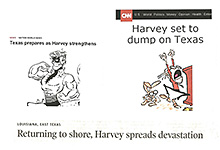
2.jpg)
3.jpg)
4.jpg)
5.jpg)
6.jpg)
7.jpg)
8.jpg)
9.jpg)
10.jpg)
11.jpg)
12.jpg)
13.jpg)
14.jpg)
